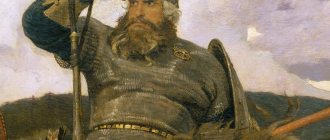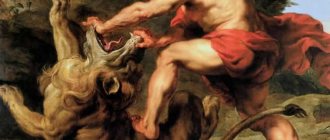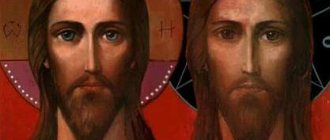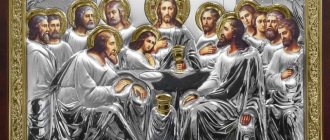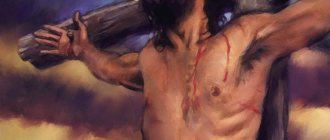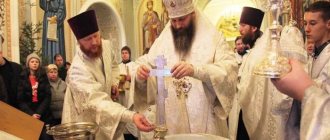ILIYA MUROMETS
I.M. is the main character of the Russian heroic epic - epics recorded in the 18th-20th centuries. mainly in the Olonets and Arkhangelsk provinces and in Siberia. The earliest mentions of the hero “Ilya (Jlias) the Russian” are contained in German knightly poems recorded in the 13th century. In recorded in ser. XIII century North German "Thidrek Saga", dedicated to one of the main characters. heroic epic to Dietrich of Berne (his prototype is the Ostrogothic cor. Theodoric the Great, conqueror of Italy (d. 526)), the ruler of Rus', Gernit, who sits in Novgorod, and his son Ilya, born of a concubine, are named “a great ruler and a strong knight.” In the battle with the Huns, Ilya defeats Dietrich Hildebrand's uncle. In the South German poem of the Lombard cycle “Ortnit”, recorded in the 20s. XIII century, Ilya from Rus' - the maternal uncle of Ortnit, ruling in Garda in Lombardy, helps to get him a bride (Veselovsky A.N. Russians and Wiltins in the saga of Tidrek of Bern (Verona). St. Petersburg, 1906. P. 137, 140, 166). This information has little in common with the image of I.M. Rus. epics, revealing a connection rather with ancient Russian. legends about the book Vladimir, Dobrynya or Volga Vseslavich.
St. Ilya Muromets. Icon. 1998 (centre of St. Elijah Muromets at the military garrison in the village of Vlasikha, Odintsovo district, Moscow region) St. Ilya Muromets. Icon. 1998 (centre of St. Elijah Muromets at the military garrison in the village of Vlasikha, Odintsovo district, Moscow region)
Unlike other epic heroes - Alyosha Popovich and Dobrynya - I.M. is not mentioned in the chronicles. In the 1st half. XV century the chronicle reflected the legend of the death of the Russians. heroes in the battle of Kalka, which served as a prototype for the epic. The main character of this legend is the Rostov “brave” Alexander (Alyosha) Popovich, who gathers heroes to protect Kyiv from the Tatars. About the heroes of the book. Vladimir is narrated by Art. “About the leadership of the Russian land” from the collection. Kirillo-Belozersky Monastery in 1568 (according to A.I. Sobolevsky, it was written at the beginning of the 16th century on Belarusian lands): “And Prince Vladimer had many brave warriors in the city of Kiev, and began to beat the great forces Polovtsian under the city near Kiev; and from then on the kings of Orda began to fear. Prince Volodimer had many brave heroes, and they began to send them to all cities and countries” (Sobolevsky. P. 18). To Belarusian. folk songs con. XV - beginning XVI century the heroes of the book are mentioned. Vladimir, who beat the “great Polovtsian forces” near Kiev. Nikon Chronicle (PSRL. T. 9. P. 68) and Life of the book. Vladimir according to the list of the Chetyih-Menya of the priest. John Milyutin (GIM. Sin. No. 807. L. 916 vol.) contain similar (apparently based on one common source) stories about the heroes of Vladimir and their exploits. The Nikon Chronicle names Alexander Popovich, the daring ragday, Yan Usmoshvets, Malvred the Strong, and Andrikh Dobryankov. I.M. is not mentioned. The list of heroes without I.M. is included in Chapter 65. 1st facet of the “Graduate Book of the Royal Genealogy” (60s of the 16th century) “On Brave Men”: Yan Usmoshvets, Ragdai, Alexander “recommended Popovich”, Malovred, Andrikh Dobryankov “and many others” (Graduate Book. 2007. T. 1. P. 323; Prince Vladimir is compared with King David, who had 37 “brave men”). Perhaps the Degree Book became the basis for the lists of heroes that are found in Russian. manuscripts of the 18th-19th centuries containing texts of a folklore nature. Apparently, in the 17th century. the name of I.M. was included in this list (the earliest Great Russian written recording of the legend about I.M. is contained in the “legend of the Kyiv heroes, how they went to Constantinople,” known in lists starting from the 17th century). In V. A. Levshin’s preface to his publication “Russian Fairy Tales” (M., 1780. Part 1. P. 4), the heroes of the book are named. Vladimir: Dobrynya Nikitich, Alyosha Popovich, Churilo Plenkovich, I.M. and nobleman Zaleshenin. In a 19th century manuscript. State Historical Museum. No. 1597 in the list of heroes “Ilya Ivanovich Muromets” is named second. The absence of chronicle mentions of I.M. prompted researchers to look for him in the chronicles under other names: interpreting the name Jlias from it. saga as Eligas, M. G. Khalansky identified I. M. with the Kyiv prince. Oleg.
Trinity Church in the village. Karacharovo. Photo. 2009
Trinity Church in the village. Karacharovo. Photo. 2009
Silence of the Great Russian. chronicles about I.M. probably indicate southwestern Russian. the origin of the legend relating to the hero. One can agree with the opinion of V.F. Miller, who wrote that the legends about I.M. found their way to the Great Russians. earth quite late. Apparently, the emergence and initial dissemination of folklore texts dedicated to I.M. are connected with the Ukrainian-Belarusian. lands, the Crimea includes the earliest - dating back to the 16th century - written evidence of the existence of a legend associated with I.M. In Aug. 1574 Philon Kmita, headman of the city of Orsha in the Grand Duchy of Lithuania, wrote to the Troki castellan Eustathius Volovich, complaining about his position “on guard” in Orsha, where he suffered hunger and cold. Kmita compared himself with I.M., who also stood “on guard” and experienced neglect from the prince. The Orsha elder concludes the letter with the words: “the hour will come when Ilya Muravlenin and Solovy Budimirovich are needed, the hour will come when our services are needed” (Źródła do dziejów polskich. Wilno, 1844. t. 2. s. 290). The headman compares himself with the heroes of the epic, who were remembered in times of danger - it is in this situation that I.M. is depicted in a number of epics. Obviously, by the 2nd floor. XVI century into Ukrainian-Belarusian. lands, a cycle of legends about the hero developed and became widespread, known from existence at a later time in another region (Russia). The prevalence of legends about I.M. in Kyiv was noted by Austrian. nobleman E. Lyasota, who visited the city in 1594. The traveler recorded that he saw in the outer vestibule of the St. Sophia Cathedral the place where “there was once the tomb of Elijah the Moravian, who was a glorious hero, as they call him here, and about whom they tell many legends” . (Lasota also writes about the tomb of “comrade” I.M. preserved in the vestibule of the St. Sophia Cathedral and about the tomb of the giant and hero nicknamed Chobotok (Ukrainian boot) in the Kiev-Pechersk monastery. When Chobotok was attacked by enemies, he turned them with his boot to flee (Diary of Erich Lyasota from Steblevo // Memoirs related to the history of Southern Rus' / Translated by: K. Melnik; Ed.: V. Antonovich. K., 1890. Issue 1. pp. 157, 159)).
St. Ilya Muromets. Icon. 2005 (chapel at the Trinity Church in the village of Karacharovo)
St. Ilya Muromets. Icon. 2005 (chapel at the Trinity Church in the village of Karacharovo)
In the extensive complex of epics about I.M., modern researchers highlight oral folk art itself, that is, epics recorded in the 18th-19th centuries. from folk storytellers (Collection of Kirsha Danilov (a copy of an earlier collection in the mid-18th century), epics collected by P.V. Kireevsky, P.N. Rybnikov, A.F. Hilferding, etc.), and epics from handwritten collections of the 17th century - beginning XIX century, which bear traces of editorial editing and processing. D.I. Ilovaisky wrote that in the epic about I.M. several can be distinguished. historical layers: associated with Kievan Rus, over Mongolian times. yoke, with the Time of Troubles. According to modern opinion. researchers, to domong. The period should include epics about meetings in the field of I.M. with enemy heroes - Zbut, Zhidovin, Sokolnik, etc., as well as epics about I.M. and Nightingale the Robber. With the Mongol era. The yoke is connected by epics about I.M. and Kalina the Tsar (the earliest record of the text is No. 25 in the collection of Kirsha Danilov), known in several years. versions (I.M., Samson and Kalin-Tsar; I.M., Ermak and Kalin-Tsar; Kama Massacre), an epic about the Idol, some versions of an epic about I.M. and the Nightingale the Robber (in them the Nightingale receives the nickname Rakhmatovich or is called Odikhmantyev’s son), etc. Events of the 17th century. reflected in the epic “Ilya Muromets on the Falcon-ship”, which tells how sailing along the Khvalynsky Sea (the ancient Russian name for the Caspian Sea) on the ship I.M. together with other heroes (sometimes with S. Razin) reflects attacks by Crimean Tatars and Turks. The epic captured memories of Cossack campaigns in the Caspian Sea, in the lower reaches of the Volga and Don (the epic is known in records from Cossack settlements in the Volga region, Siberia, and villages in the Vologda and Vyatka provinces). I.M.’s possible historical prototype for this plot was the impostor False Peter, the Cossack Ileiko Muromets, who participated in Cossack campaigns against the mountain tribes and fought against Tsar Vasily Ioannovich Shuisky. (The story of False Peter is set out in the “Royal letter to Sol Vychegda about a three-day prayer service on the occasion of the surrender of the city of Tula by the rebels to the royal troops and the extradition of the impostor False Peter, with the attachment of the latter’s testimony about his family” dated October 19, 1607 - AAE. T. 2. No. 81. pp. 173-176. Ileyka's nickname, Muromets, is associated with his origin from Murom. Having declared himself the son of Tsar Theodore Ioannovich, the impostor did not claim a connection with the epic hero.)
St. Ilya Muromets. Icon. 2008 Icon painter I. V. Sukhov (private collection, Moscow)
St. Ilya Muromets. Icon. 2008 Icon painter I. V. Sukhov (private collection, Moscow)
The image of I.M. is found in the “tale of the Kyiv heroes, how they went to Constantinople” (lists of the 17th-18th centuries), in the “Tale of the Seven Bogatyrs” (the earliest list of the 1st quarter of the 18th century), in the epic about Mikhail Potyk. I.M. appears as a symbol of a hero, like everyone living on earth, powerless against death, in a special edition (or version) of “The Tale of the Debate between the Belly and Death,” presented in the Old Believer collection of the 3rd quarter. XVIII century - RSL. Collection A. I. Markushevich. No. 22. L. 70 vol. - 73 vol. (this edition of “The Tale...” is not taken into account in the monograph-publication: Dmitrieva R.P. The Tale of the Dispute of Life and Death. M.; Leningrad, 1964). In the records of con. XIX century There is an epic about the meeting in the field and the clash between I.M. and Dobrynya. Researchers recorded the appearance of new plots in the epic about I.M. until the 60s. XX century: an epic about the marriage of I.M., recorded in Pudozhye at the end. 30s XX century (Epics of the Pudozh region. No. 50), and a number of epics by M. S. Kryukova about the exploits of I. M. (Epics of M. S. Kryukova. T. 1. No. 10, 12, 13, 15).
The most common and ancient are the epics about I.M. and the Nightingale the Robber. The plots “Ilya and the Thieves”, “Ilya and the Idol”, “The Healing of Elijah Sidnya”, found in the oral tradition as independent epics, in manuscripts of the 18th - early 19th centuries. XIX century combined with stories about I.M. and Nightingale the Robber. Researchers divide epics about I.M. and Nightingale the Robber from handwritten collections into 2 versions: in the 1st version, I.M. liberates the city of Sebezh on the way from Murom to Kiev (the city has been known since the beginning of the 15th century, now in Pskov region) (Sebezh version), in the 2nd edition the hero liberates Chernigov (Chernigov version). Within each group, several are distinguished. editorial staff
The overwhelming majority of epics tell about the origin of I.M. from Murom (the city probably arose at the turn of the 10th and 11th centuries, now the regional center of the Vladimir region). According to later editions of epics from handwritten collections, I.M. was from the city itself. Most of the texts of the Sebezh version say that the hero was born in the village. Korochaevo near Murom. Some texts say that he was the son of the peasant Ivan from the village. Lapteva or the village of Kaptyaev, in other epics the social status of I.M. is not specified, but the name of his father is given - Ivan Eleferievich (“old mother” in Murom). In the texts of the Chernigov version, I.M. is the son of the peasant Ivan Timofeevich from the village. Karacharova (the village has been known since the 17th century, now within the boundaries of Murom; in the 19th century, the peasants Ilyushins lived in the village, who traced their origins to I.M., now the Gushchins living in Karacharovo consider themselves descendants of I.M. which has been known since the 19th century). In oral epics, the names of the hero’s parents are Ivan Timofeev and Evfrosinya Yakovleva. In a number of epics, the city of Morov is named as the birthplace of I.M., and the nicknames I.M. are found with this name are Morovets, Murovets, Muravlenin, Morovlyanin. These facts gave rise to V.F. Miller to suggest the origin of I.M. from the one mentioned in chronicles from the 12th century. the city of Moroviysk in the Chernigov principality (now the village of Morovsk, Chernigov region, Ukraine). According to the scientist’s hypothesis, after the transfer of the folklore tradition dedicated to I.M. from the southwestern Russian lands to Russia, Moroviysk was transformed into Murom. The researcher considered Karacharovo to be a modified name of Old Russian. the city of Karachev (known since the 12th century, now in the Bryansk region). With Karachev by the 19th century. there were many local legends about I.M.: not far from the city, near the village. Nine Oaks, the hero fought with the Nightingale the Robber. Here they showed the Smorodinka River, the stump left from 9 oak trees, on which the Nightingale sat (Miller. 1924. T. 3. P. 86-90).
Apparently, in the oldest legend about I.M., the place of his birth was indicated by Moore, as this is told in the overwhelming majority of epics and as evidenced by those related to the story. XVI century place names of Murom (see below). Nicknames of I. m., recorded in Ukrainian-Belarusian. lands (Murovlyanin, Morovlyanin (see the evidence of Philo Kmita and Lyasota)), are probably the result of the existence of legends about the hero among the Eastern Slavs. population of the Polish-Lithuanian Commonwealth in the context of the disappearance of knowledge there about the realities of Muscovite Rus'. the derivation of these nicknames from Morovsk seems unlikely, since the city, burned during princely civil strife in 1175, was restored no earlier than the 16th century; In addition, no local legends about I.M. are associated with Morovsk. It seems interesting that the indicated nicknames of the hero coincide with the ancient Russian ones. the designation of the inhabitants of Moravia (for example, the Moravlians (Maravlians, Moravlyans, Morevlans) are mentioned in the word “On the praise of the Mother of God of Cyril the Philosopher", the oldest list of which (Russian) dates back to the 15th century (Turilov A.A. On the history of the Great Moravian heritage in literature of the southern and eastern Slavs: (The word “On the praise of the Mother of God of Cyril the Philosopher,” in the handwritten tradition of the 15th-17th centuries // Great Moravia: Its historical and cultural significance. M., 1985. pp. 260-261); in The Nikon Chronicle refers to the Slavs who settled on the banks of the Morava River as “Maravians” (PSRL. T. 9. P. 3). Perhaps the “Moravian” nickname of I.M. appeared under the influence of what was reflected, in particular, in the “Tale of Bygone Years” "and in other texts understanding the special significance of the Great Moravian state for Rus' and for the entire Slavs: Moravia here appears as the physical and spiritual homeland of all Slavs, the place of the preaching of the Apostle Paul and the works of Equal-to-the-Apostles Cyril (Constantine) and Methodius. Old Russian state , according to the author of PVL, is the successor of Great Moravia (see about the perception of Great Moravia. heritage in Dr. Rus': Rogov A.I. Great Moravia in the writing of Dr. Rus' // Great Moravia: Its historical and cultural significance. pp. 269-281). It can be assumed that the synonym for the nickname Morovlyanin in relation to I.M. is “Slav” and the nickname should refer to the conventional time of common slavs. antiquities. (In later chronicle texts, instead of the name Moravia, the toponym Murom may be used: “And some of the Slavs remained in ancient times on the Danube, but their city is Murom” (Gilyarov F.A. Traditions of the initial Russian chronicle. M., 1878. P. 5). )
St. Ilya Muromets. Icon. 2000-2001 Icon painter N. Churbanov (C. St. Elijah of Muromets at the Verbovsky cemetery in Murom)
St. Ilya Muromets. Icon. 2000-2001 Icon painter N. Churbanov (C. St. Elijah of Muromets at the Verbovsky cemetery in Murom)
A number of researchers question the peasant origin of I.M. According to Ilovaisky, “at the end of the Kyiv period, Ilya, apparently, was considered a noble person” (Ilovaisky. 1893. p. 40). Ilovaisky’s assumption, as one might think, is confirmed by epics, in which it is reported that the hero was literate: “At the well he cut down a damp oak, / At the well he erected a chapel, / On the chapel he wrote his name: / “So-and-so strong rode mighty hero / Ilya Muromets son Ivanovich" (Buslaev F.I. Russian Reader... for secondary educational institutions. M., 190911. P. 390). Stories about the peasant origin of the hero appear in epics from handwritten collections and in epic stories of later times, in particular in the epic about the healing of I.M. In the epic about I.M. and the Nightingale the Robber from the collection of Kirsha Danilov (the earliest entry dates back to the turn XVII and XVIII centuries) there is no such topic.
The epic about the healing of I.M. tells that because of the sin of his grandfather, I.M. did not control his legs until he was 30 years old (he was a “sidney”), he prayed and bowed day and night. after unknown wanderers gave him water to drink, he stood up and felt extraordinary strength in himself. In the epics of the Sebezh version, I.M. was healed by “walking kalikas” (pilgrims) on the eve of the prophet’s holiday. Elijah. In the 2nd half. XVIII century an unknown scribe made an attempt to transform the epic about I.M. into a hagiography, writing “The History of the glorious, brave and strong hero Ilya Muromets son Ivanovich and Nightingale the Robber” (known in 3 Russian lists: Monuments of Russian Folklore. No. 10- 12). According to “History...”, the hero was healed through prayers to St. Nicholas the Wonderworker. I.M.’s parents made a vow to serve a prayer service to the saint annually in the event of the birth of a son. The child was born "sydney". On the day of his feast day, St. Nikolai appeared to the hero and asked for a drink, to which he replied that he could not “get to his feet.” The saint said: “Arise and walk!” - and became invisible. I.M. put on armor and asked his parents for their blessing to go to Kyiv. They instructed their son not to offend anyone on the way and not to spill Christ in vain. blood. In oral epics, the story about the blessing is more extensive. When I.M. asked his father to bless him for military feats, he hesitated. Then the hero went out to the Oka, rested his shoulder on the mountain and moved it, blocking the river bed. I.M.’s horse made the journey from Murom to Chernigov in 3 leaps. When the horse made its first leap, a spring of “living water” struck from under its hooves. These details are reflected in the topography of Murom. In the hundredth copy of the Murom Posad in 1574, Bogatyreva Mountain is mentioned “opposite the Oka River” and “Skokova Gora” “in an alley in the Posad” (Legal Acts. St. Petersburg, 1838. No. 229. P. 250). According to V.I. Dahl, in the 19th century. near Murom they showed the old riverbed of the Oka, filled up by I.M., above the source of “living water” there was a chapel in the name of the prophet. Elijah (Songs, collected by P.V. Kireevsky. P. XXXIII).
St. Ilya Muromets. Gravestone image. 1844 Master I. Erikson (Near Caves of the Kiev Pechersk Lavra)
St. Ilya Muromets. Gravestone image. 1844 Master I. Erikson (Near Caves of the Kiev Pechersk Lavra)
On the way to Kyiv, I.M. liberated, according to the Chernigov version, Chernigov from the Basurman army, according to the Sebezh version, Sebezh from the 3 overseas princes who besieged it. The Tsar of Sebezh persuaded the hero to remain in the service, promising half the kingdom, but I.M. did not agree and asked to be shown the direct road to Kyiv. The king said that because of the attacks of the Nightingale the Robber, no one travels along the road. Having defeated Nightingale, I.M. found out from him where his treasury was kept and went to the “Kutuzov villages,” where Nightingale’s sons lived. V. A. Kravchinskaya pointed out the prevalence of con. XV century the Kutuzov surnames in the Pskov lands, where Sebezh texts existed. In most oral versions of epics, not Sebezh is named, but Chernigov and other cities (Smolyanin, Smolensky, Titov, etc.), “Kutuzov villages” are not mentioned. In the texts of the Chernigov version it is not the sons, but the daughters of Nightingale who appear. According to V.F. Miller, Belarusian. Sebezh could have appeared in epics about I.M. in the 16th-17th centuries, when the Russian state fought with Poland for this border city.
The epic about I.M. and Nightingale the Robber ends with a story about the hero's trial in Kyiv. Book Vladimir generously rewarded I.M. Some epics of the Sebezh version say that I.M. brought his parents to Kyiv, got married and lived happily to old age. Other texts say that Vladimir released I.M. “quiet” (Monuments of Russian Folklore. P. 41). Quite old (in particular, reflected in the letter of Philo Kmita in 1574) is the epic story about the conflict between I.M. and Prince. Vladimir, who did not honor the hero. Sometimes the texts of the Sebezh version contain a story about I.M.’s victory over Tsar Tukhman (the plot is not known in oral folklore); in the Chernigov texts such an addition is a story about the victory over the “Filthy Idol”. In oral epics, the end of I.M.’s life is either presented as petrification in a rock, or is associated with the Kyiv caves. According to the rather late Onega epic “On the Three Trips of Ilya Muromets,” “when the old man built the Indian church and began to build the cave church, Tutova was old and petrified.” The epic ends with the words: “Yes, to that verse they sing glory” (Kireevsky. 1868. P. 89). Another epic tells how, having found “belly-richness,” I.M. “erected his belly into the glorious city of Kiev / And he built a cathedral church / Here Ilya turned to stone / And to this day his relics are incorruptible” (Rybnikov. 1864 T. 3. P. 53).
Cancer with the relics of St. Ilia Muromets (Nearby caves of the Kiev-Pechersk Lavra)
Cancer with the relics of St. Ilia Muromets (Nearby caves of the Kiev-Pechersk Lavra)
In all epics, I.M. acts as a defender of Christ. faith and orthodoxy Churches. According to O. F. Miller, a characteristic feature of a hero is the ability to “not fall under passion”: he is not tempted “by beauty, by gold, by power, by any kind of personal sweetness” (Miller O. F. 1870. P. 789). I.M. is fair and peaceful: “Ilya does not strike willingly, but only in extreme cases; and where there is no need for this unpleasant for him, he only shows harmlessly his heroic strength in order to force him to yield to himself” (Aksakov K.S. Personal memories // Kireevsky. 1868. P. XXX). These qualities made I.M. a favorite hero of the folk epic, therefore the canonization of the hero, which, according to O.F. Miller, was already reflected in epics, was quite natural.
Description of the icon
In holy images, the Monk Elijah is depicted with a staff in the form of a sword. Each icon emphasizes the heroic build of a seasoned warrior. His huge hands rest confidently and calmly on the handle of a staff that resembles a fighting weapon. Despite the fact that the famous hero died at the age of 45-50, he is depicted on icons with a long white beard and intelligent, tired eyes. The entire holy face symbolizes wisdom and peace.
The saint's head is covered with a hood, which is crowned with a schematic cross, meaning Golgotha. On different icons you can see a hood from blue to black, but everywhere it is, as a rule, in the form of a helmet, which emphasizes the fighting spirit of the monk.
Icon of Ilya Muromets
Old age reveals a noble oval face and clarity of eyes, tightly compressed lips personify will and endurance.
The right hand is raised in holy baptism, with the last two fingers pressed against the palm and three joined together. With this gesture, the unknown artist wanted to emphasize that Ilya Muromets is a true Orthodox believer.
Brief life of the saint
The name of this saint of God is known to all believers. Very little reliable information about the life of this saint has survived to this day.
He came from a simple peasant family. In childhood and adolescence he suffered from paralysis, but was miraculously healed. Before his tonsure, he was a member of the princely squad and became famous for his military exploits and unprecedented strength. Resting in the Anthony Caves are the relics of St. Elias show that for his time he really had a very impressive size and was a head taller than a man of average height.
Epic hero
History of creation
Every year on January 1, Orthodoxy commemorates the memory of St. Elijah. The man met old age in the Pechersk Lavra and died at the hands of the cruel Polovtsians. Studies of the remains of the martyr confirm the opinion that the hero Ilya Muromets is not a fictional character, but a real person.
Ilya Pechersky - the alleged prototype of Ilya Muromets
An analysis of the relics, which scientists carried out in 1988, indicates specific features: the deceased man suffered from a rare disease that affects the ability to move. Traces of wounds were found on the bones and tissues of the saint. The listed facts give reason to assert that Elijah Pechersky (the man is buried under this name) is a prototype of a mighty hero.
Perhaps the exaggerations that are characteristic of tales and legends are the consequences of constant retelling. Or the creators of the epics added metaphors to the story to impress the listeners.
Relics of Elijah of Pechersk
Muromets was indeed different from his contemporaries. The description of the hero (confirmed by scientists) proves that the warrior’s height was 177 cm. The average height of men in Ancient Rus' did not exceed 160 cm. It is necessary to mention quotes from Boris Mikhailichenko, a researcher of the relics:
“...on the bones of the mummy the so-called tuberosities are very well developed. And we know that the better a person’s muscles are developed during life, the more these tubercles he will have. That is, he had a developed muscular system.”
“In addition, an X-ray examination of the skull revealed changes in the part of the brain called the sella turcica.” At all times there are people with such symptoms, they say about them - “oblique fathoms in the shoulders.”
The first written mention of Ilya Muromets dates back to 1574. The Lithuanian governor, in a note to Ostafy Volovich, casually mentions the brave warrior “Ilii Murawlenina” and the imprisonment of the Russian hero in the dungeon of the Kyiv prince.
There is a theory that handwritten evidence of the exploits of Muromets was deliberately destroyed. The hero's supposedly humble origins cast a shadow on the boyar warriors and their descendants.
How legitimate is the identification of St. Elijah of Pechersk with the epic hero of the same name?
In the 19th century, some researchers questioned the possibility of identifying St. Elijah of Pechersk with the epic hero of the same name. However, there is no doubt that for our Orthodox ancestors it was one person.
Epic hero
For example, a pilgrim of the 18th century (Leonty) in his notes says: “Seeing the brave warrior Ilya of Murom, incorruptible under the cover of gold; tall like today's large people; his left hand is pierced by a spear, the ulcer is all over; and the right is depicted with the sign of the cross.” Believers have no doubt about this.
The incorrupt relics of the saint
The relics of the saint testify to his military biography
He is the main character not only of our epics, but also of German epic poems of the 13th century, based on earlier legends. In them he is represented as a powerful knight, the princely family Ilya the Russian. The relics of the monk no less clearly testify to his vivid military biography - in addition to a deep round wound on his left arm, one can see the same significant damage in the left chest area. It seems that the hero covered his chest with his hand, and with a blow from a spear it was nailed to his heart. After a completely successful military career and, apparently, as a result of a serious injury, Elijah decides to end his days as a monk and takes monastic vows at the Theodosius Monastery, now the Kiev Pechersk Lavra.
It should be noted that this is a completely traditional step for an Orthodox warrior - to exchange the iron sword for the spiritual sword and spend his days fighting not for earthly blessings, but for heavenly ones. St. Elijah is neither the first nor the last warrior to do this. In this regard, among our compatriots we can recall the great commander Rev. Alexander Nevsky, as well as professional warriors Peresvet and Oslyabyu, who passed obedience under the supervision of Rev. Sergius of Radonezh and those who died heroically on the Kulikovo Field.
On patrol
